Within the vibrant mosaic of the LGBTQ+ society, pride flags serve as potent symbols of selfhood, cohesion, and fortitude. Each flag carries a distinct amalgamation of hues and symbols, embodying the diverse array of sexual inclinations, gender identities, and expressions within the community. From the renowned rainbow flags to less acknowledged variations, these LGBTQ+ flags serve as visual manifestations of pride, camaraderie, and inclusiveness.
In this all-encompassing manual, we delve into the opulent array of pride flags and their connotations, delving into the tales, symbolism, and import behind each unique emblem. From the Abrosexual Pride flag to the Transgender Pride flag, we unravel the complexities of these symbols, casting light on the encounters and identities they signify.
21 Different Pride Flags & What Do They Mean
Agender Pride Flag
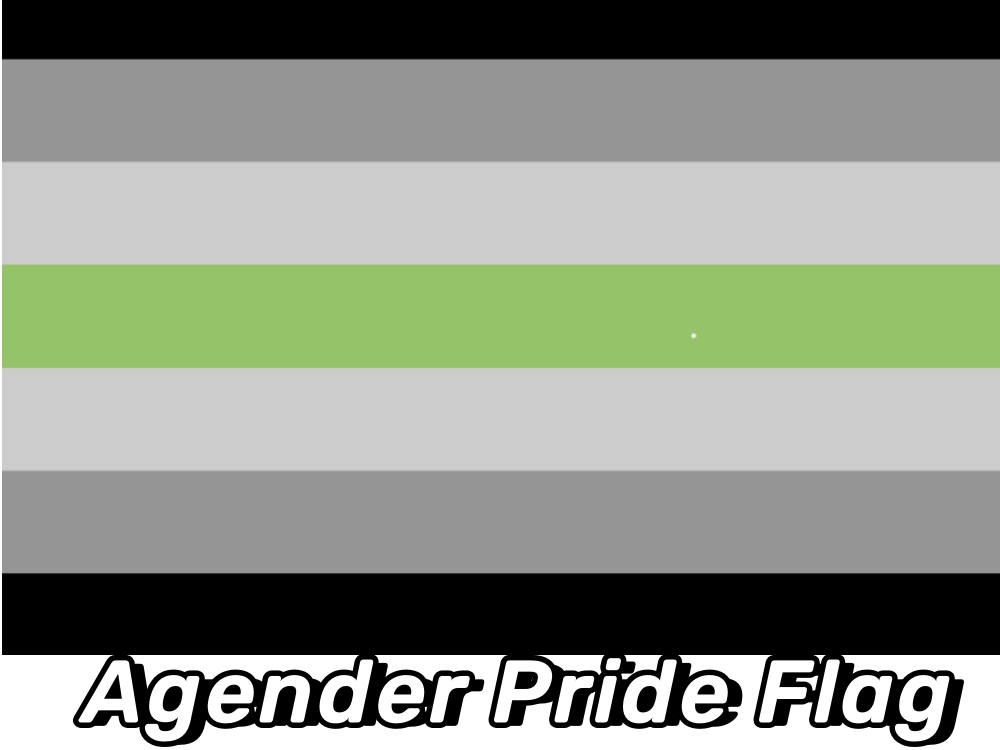
The Agender Pride Flag serves as a symbol representing individuals who are recognized as agender, denoting they do not associate with any gender. Usually, the flag comprises four horizontal stripes, with colors from top to bottom being black, gray, white, and green.
The black stripe signifies agender identity, the gray stripe denotes partial genderlessness, the white stripe symbolizes gender neutrality, and the green stripe represents non-binary identities beyond the binary spectrum. The flag was crafted to offer a visual depiction and a sense of community for individuals identifying as agender.
Abrosexual Flag

The Abrosexual flag represents the abrosexual identity, signifying individuals who undergo fluidity in their sexual orientations, where attractions fluctuate or alter over time. The term "abrosexual" arises from the prefix "abro-" meaning "away" or "off," coupled with "sexual."
Typically, the Abrosexual Flag consists of five horizontal stripes arranged from top to bottom, each carrying significance.
The flag aims to symbolize the nuanced experiences of individuals identifying as abrosexual, highlighting the fluidity and variability in their sexual orientation over time.
Asexual Pride Flag
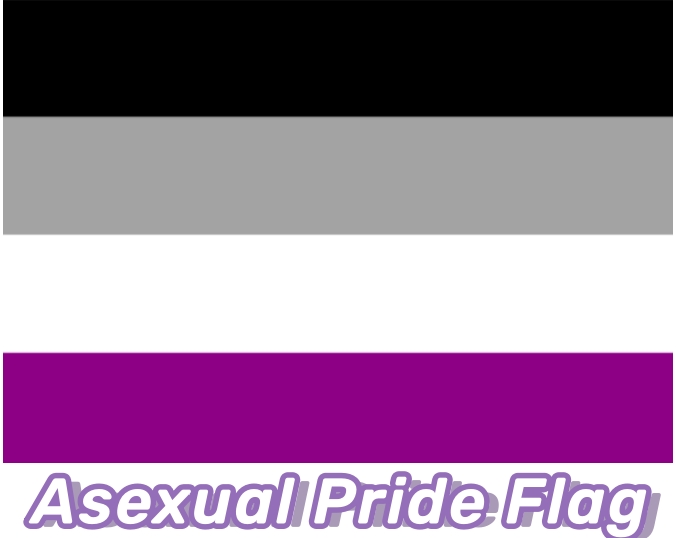
The Asexual Pride Flag symbolizes the asexual community, comprising individuals who do not undergo sexual attraction or possess low interest or desire for sexual activity.
Crafted in 2010 by AVEN (Asexuality Visibility and Education Network), the flag consists of four horizontal stripes: Black symbolizes asexuality, Gray signifies gray-asexuality and demisexuality, White represents sexuality, and Purple denotes community and solidarity among asexual individuals.
The flag was devised to represent the diverse experiences within the asexual community and foster acceptance and understanding of asexuality as a legitimate sexual orientation.
Bigender Pride Flag
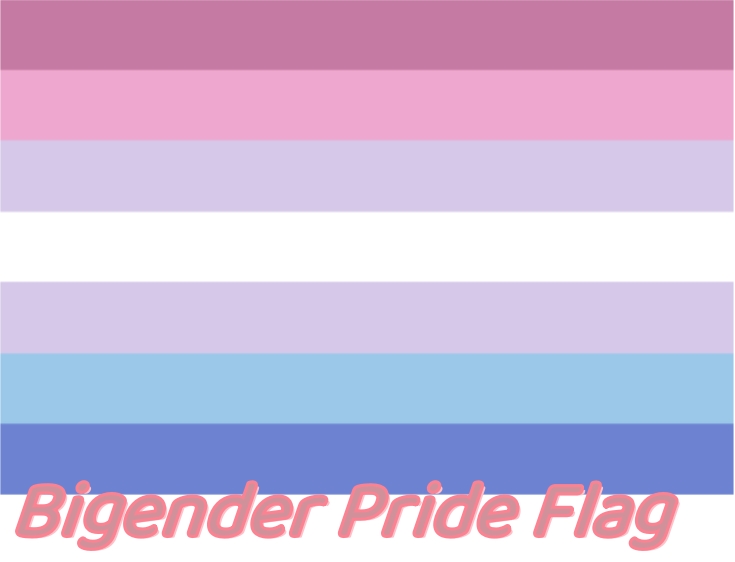
The Bigender Pride flag serves as a symbol representing individuals who identify as bigender, experiencing two distinct gender identities simultaneously or at different times. This identity may encompass toggling between masculine and feminine genders, embodying aspects of both genders, or undergoing fluidity between genders.
Typically comprising five horizontal stripes, each with its own color and significance, the flag symbolizes androgyny, non-binary or agender identity, and those identifying outside the traditional gender binary. The flag strives to provide visibility and acknowledgment for individuals identifying as bigender, celebrating the diversity of gender experiences and expressions within the LGBTQ+ community.
Bisexual Pride Flag
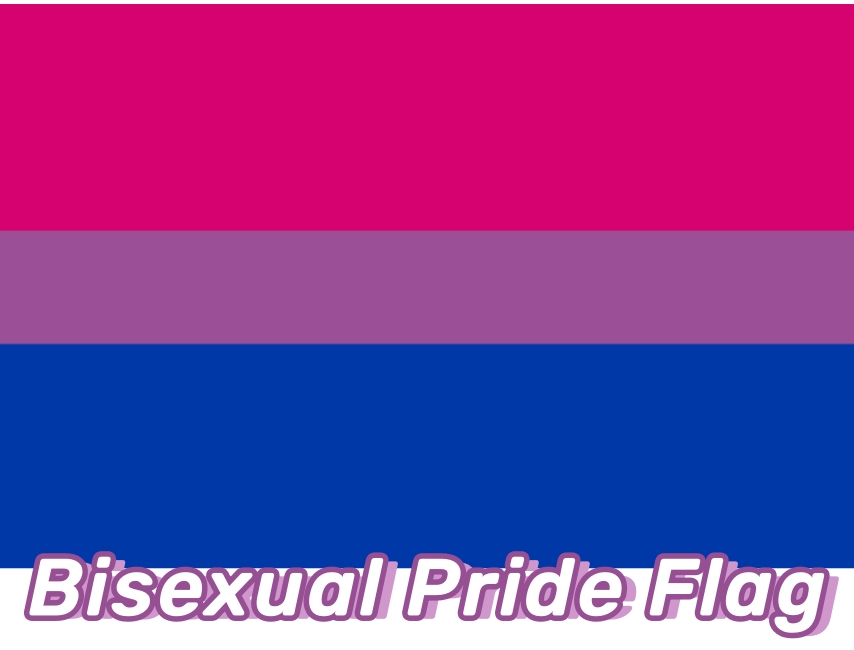
The Bisexual Pride flag is a widely recognized symbol representing individuals identifying as bisexual, acknowledging attraction to more than one gender. Designed in 1998 by Michael Page, the flag features three horizontal stripes, with Pink representing same-sex attraction, Blue symbolizing opposite-sex attraction, and Purple signifying the blend or overlap of these attractions, reflecting the bisexual experience.
The flag serves multiple purposes within the LGBTQ+ community, offering visibility and recognition for bisexual individuals, fostering a sense of belonging and unity among them, promoting understanding and acceptance of bisexuality, challenging stereotypes, and promoting inclusivity within broader society.
Demiboy Flags

The Pride flag for Demiboy individuals symbolizes those who embrace a gender identity under the non-binary umbrella. They feel partially connected to masculinity but also experience detachment or only partial alignment with it.
Featuring horizontal stripes of varied colors, the flag typically showcases three significant hues:
- Blue: Representing traditional masculinity and maleness, acknowledging the partial connection Demiboy individuals may feel with the male gender.
- White: Symbolizing non-binary or gender-neutral identity, recognizing that Demiboy individuals may not fully identify with the male gender and may experience their gender in a more fluid or neutral manner.
- Grey: Reflecting a spectrum of genders and the blending of male and non-binary identities, mirroring the nuanced experiences of Demiboy individuals who may not fit neatly into traditional gender categories.
The Demiboy Pride flag serves as a visual emblem and source of pride, providing visibility and recognition within the LGBTQ+ community. It acknowledges the complexity and diversity of gender experiences, promoting acceptance and understanding of non-binary identities. Additionally, the flag fosters a sense of solidarity and community among Demiboy individuals and their allies, affirming the validity of their gender identities.
Demigender Pride Flag
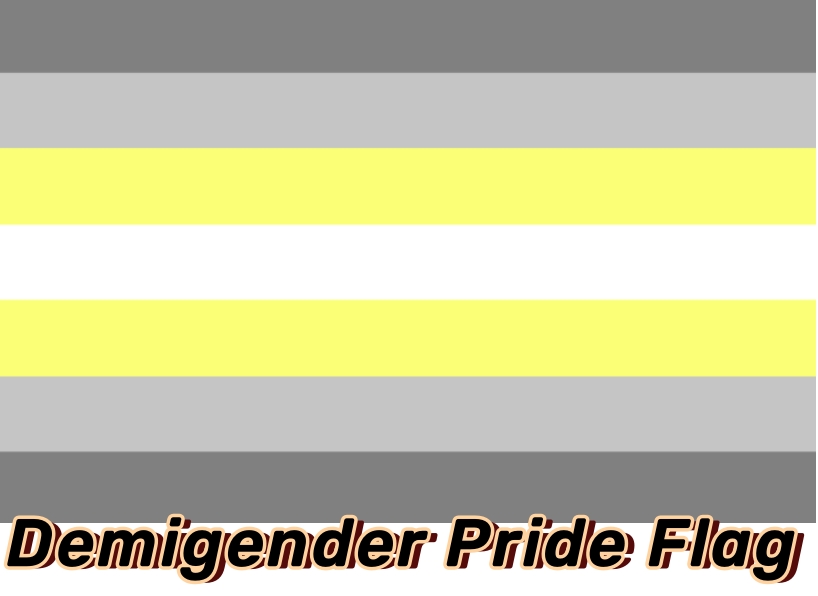
The Demigender Pride Flag is a vibrant symbol representing a distinctive aspect of the diverse gender spectrum. For those identifying as demigender, their gender identity is marked by a partial connection to a specific gender, coupled with a sense of detachment or only partial alignment with it.
Featuring a total of seven stripes, the demigender pride flag displays two outer bands in gray, succeeding two in lighter shades of gray, and two in yellow, with a solitary white stripe positioned centrally.
Although lacking a widely acknowledged significance, it's theorized that the differing hues of gray potentially denote diverse levels of gender ambiguity and partial identification with a particular gender. The central white stripe may signify the encompassment of all genders, akin to its role on the non-binary flag, while the yellow bands may represent genders diverging from conventional masculinity and femininity.
Drag Feather Pride Flag
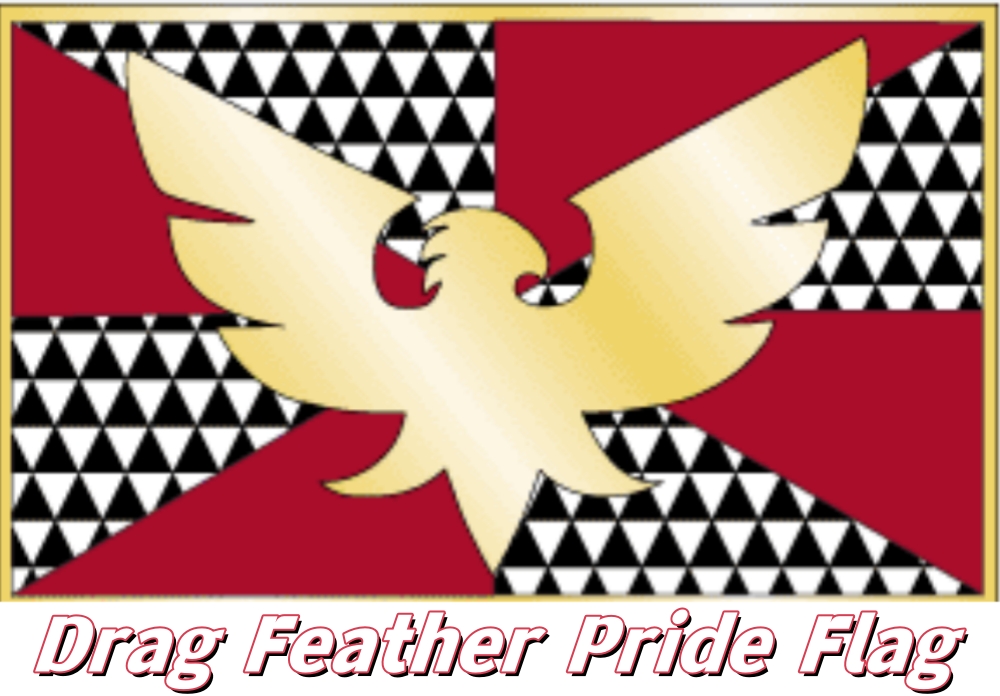
The Drag Feather Pride Flag is a vibrant symbol representing the drag community, a diverse group of performers who utilize clothing, makeup, and exaggerated gender expression to entertain and express themselves creatively.
While lacking a universally recognized design, a typical version often features a kaleidoscope of colors, reminiscent of the LGBTQ+ Pride Flag, alongside elements such as feathers, sequins, or other embellishments evoking the flamboyant and theatrical nature of drag performance.
This flag serves as a celebration of drag culture and the artistry, creativity, and self-expression inherent within it. It provides visibility and recognition for drag performers, acknowledging their significant contributions to LGBTQ+ culture and their role in challenging gender norms and promoting acceptance and diversity.
The Drag Feather Pride Flag acts as a unifying symbol for the drag community, fostering a sense of pride, solidarity, and belonging among performers and their supporters. It represents a space where individuals can freely express themselves and embrace their unique identities, regardless of gender or sexual orientation. Ultimately, the flag embodies the spirit of inclusivity, acceptance, and celebration that defines drag culture worldwide.
Gay Men’s Pride Flag

The Gay Men’s Pride Flag emerges as a distinctive emblem within the LGBTQ+ spectrum, albeit less recognized than its rainbow counterpart. This modern iteration exhibits a palette adorned with varying hues of green, blue, and purple, marking a departure from its earlier rendition characterized by predominantly blue tones.
The previous version, steeped in hues stereotypically associated with the gender binary, underwent evolution to embrace inclusivity. This updated flag aims to encompass a broader spectrum of gay men, transcending boundaries to include transgender, intersex, and gender nonconforming individuals.
As the rainbow pride flag evolved to symbolize the entirety of the LGBTQ+ community, the need arose for a distinct emblem specifically tailored to represent gay men. In 2019, a proposal for the design surfaced on Tumblr, igniting both acclaim and controversy. Initially criticized for alleged transphobia and resemblances to the lesbian flag, the flag eventually gained acceptance within the community.
Comprising five primary colors, occasionally expanded to seven, the flag's spectrum spans from verdant greens to pristine whites and regal purples. The green and turquoise hues embody notions of community and healing, while white signifies inclusivity for gender nonconforming, transgender, and non-binary individuals. Finally, the gradient from blue to purple encapsulates themes of love, diversity, and fortitude.
Genderflux Pride Flag
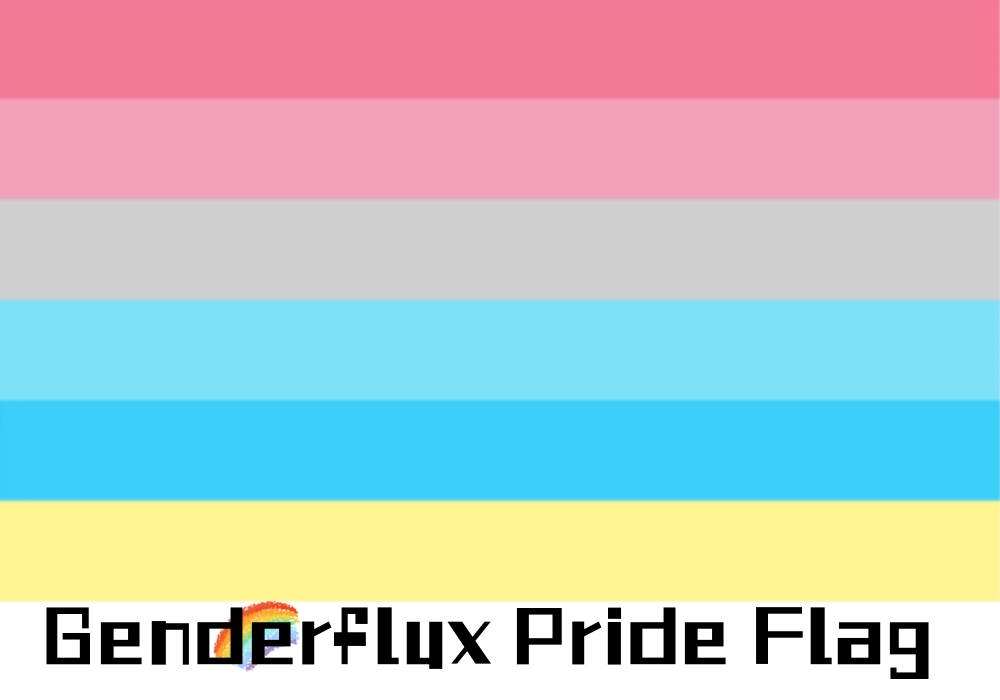
The Genderflux Pride Flag is a vibrant emblem reflecting the fluidity of gender experienced by individuals identifying as genderflux. Comprising five horizontal stripes, each represents different aspects of gender identity.
The creator of the genderflux pride flag remains a mystery, although three new variations have surfaced, the initial version remaining the most prevalent. The flag consists of six stripes, each representing a distinct color with its own significance: dark pink symbolizes women, light pink denotes demigirls, grey represents agender, light blue signifies demiboys, dark blue embodies men, and yellow symbolizes non-binary genders.
This flag serves as a visual representation and source of pride for genderflux individuals, celebrating the diversity and complexity of their gender experiences. It fosters a sense of community and acceptance within the LGBTQ+ spectrum, affirming the validity of non-binary and fluid gender identities.
Gender Queer Pride Flag

The Emblem of Genderqueer Pride stands as a vivid representation denoting the multitude and malleability of gender identities extending beyond the conventional binary construct. Crafted in 2011 by Marilyn Roxie, this emblem swiftly earned its place as a treasured symbol among individuals embracing genderqueerness, renouncing conventional gender paradigms.
Composed of three horizontal stripes, each hue bears its own profound significance:
- 1. Purple: Echoes androgyny and queerness, exalting the fusion of masculine and feminine attributes and the singular beauty found in deviance from norms.
- 2. White: Signifies a repudiation of the binary model of gender, welcoming agender, non-binary, or gender-neutral identities. It embodies the liberty to exist beyond the boundaries of traditional gender classifications.
- 3. Green: Represents the expansive spectrum of gender identities transcending the conventional binary system, encompassing diverse experiences such as gender fluidity, third gender, and other non-binary identities.
This emblem serves as a radiant beacon of empowerment and visibility for genderqueer individuals, nurturing a sense of pride, unity, and acceptance within both the LGBTQ+ community and society at large. It confronts societal conventions, advocating for inclusivity and comprehension of all gender identities.
Graysexual Pride Flag
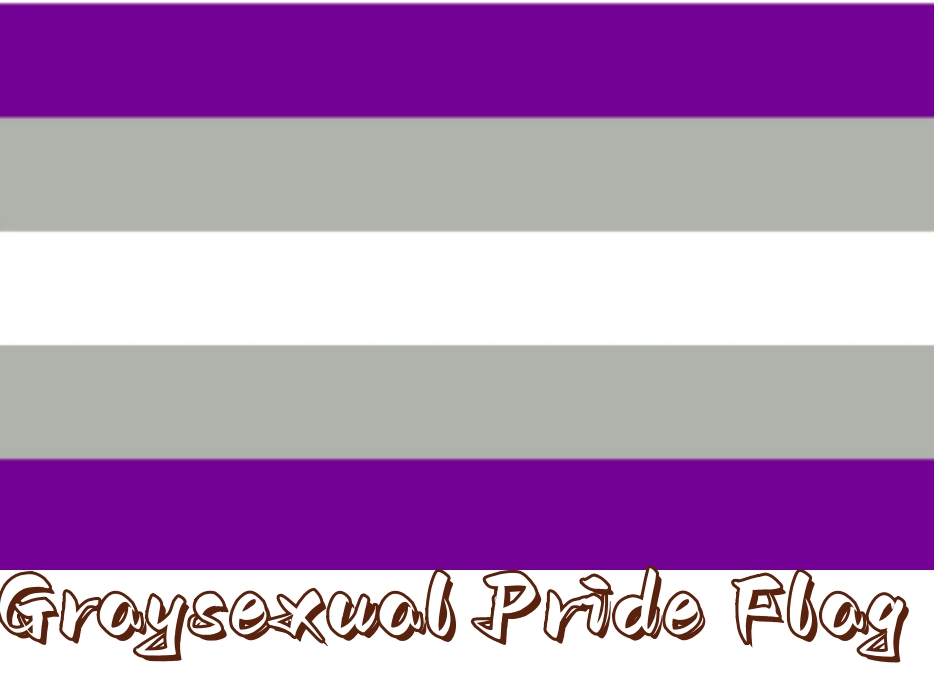
The Graysexual Pride Flag symbolizes individuals identifying as graysexual, also termed gray-asexual. Graysexuality is characterized by sporadic or limited sexual attraction, residing somewhere between asexuality and allosexuality.
This pride flag typically showcases shades of gray, emblematic of this spectrum of sexual attraction, often accompanied by additional hues or symbols representing related identities or experiences within the graysexual community. It strives to offer visibility and acknowledgment to graysexual individuals, affirming the validity of their experiences within both the LGBTQ+ community and broader society.
Intersex Pride Flag
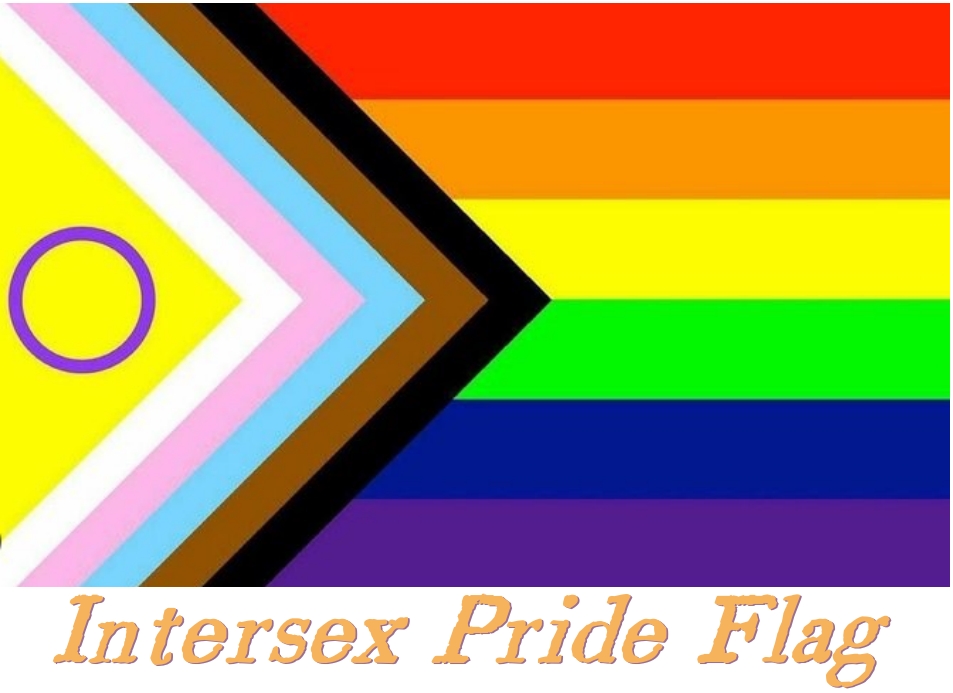
The Intersex Pride Flag represents intersex individuals and their journeys. Conceived by Morgan Carpenter in 2013, it features a golden yellow backdrop adorned with a purple circular emblem at its core.
These colors were selected to sidestep gender stereotypes and to epitomize the necessity for autonomy and integrity within the intersex community. The circle symbolizes wholeness and completeness, emphasizing the dignity and entitlements of intersex individuals. This flag endeavors to champion the visibility, recognition, and acceptance of intersex individuals within the LGBTQ+ community and society at large.
Lesbian Pride Flag

The Lesbian Pride Flag is an emblem symbolizing the lesbian community and its multifaceted identities. Back in 2019, Emily Gwen, a Twitter user, shared a revamped version of the lesbian flag, gaining rapid popularity for its embracement of butch and trans women, along with gender non-conforming individuals.
It aims to celebrate and empower lesbians, affording them visibility and acknowledgment within both the LGBTQ+ community and beyond. It stands as a symbol of pride, unity, and resilience, fostering a sense of belonging and acceptance for lesbians globally.
Maverique Pride Flag
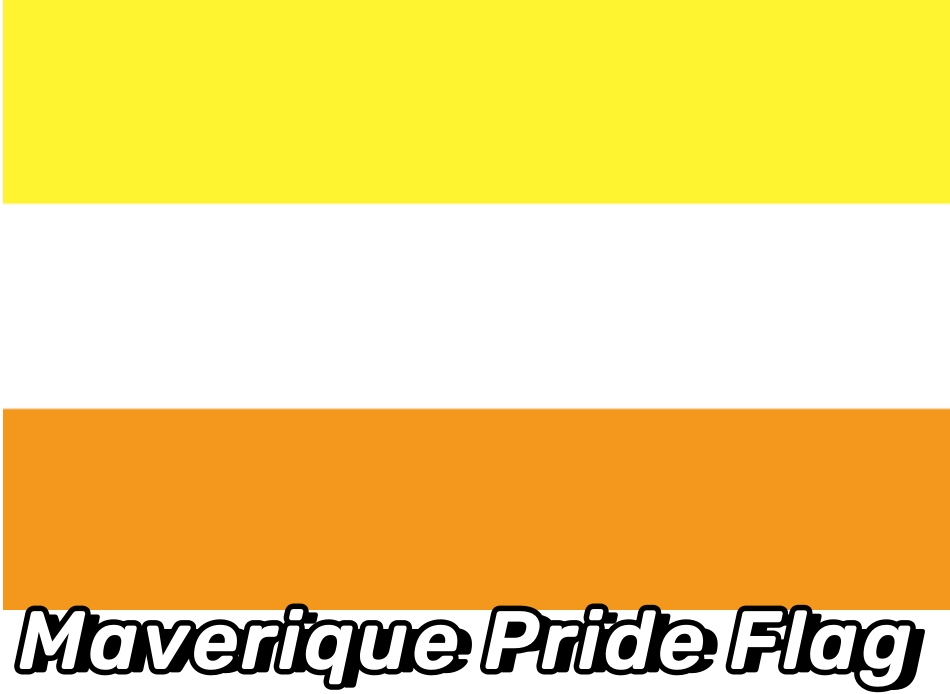
The Maverique Pride Flag symbolizes individuals identifying as maverique, a term delineating a distinct gender identity lying beyond conventional binary classifications.
Coined by Tumblr user Vesper H. in 2014, maverique alludes to a unique and autonomous gender identity not confined to solely masculine or feminine attributes. Instead, maverique individuals often perceive their gender as wholly distinct and incomparable to traditional gender constructs.
The Maverique pride flag features yellow, white, and orange hues, each carrying symbolic significance. Yellow symbolizes non-binary gender, analogous to the independence and uniqueness of maverique identities. White represents autonomy from gender binaries and the diverse spectrum of genders. Orange embodies the inner conviction and individualistic nature of mavericks, reflecting their unorthodox perspectives on gender.
Non-Binary Pride Flag
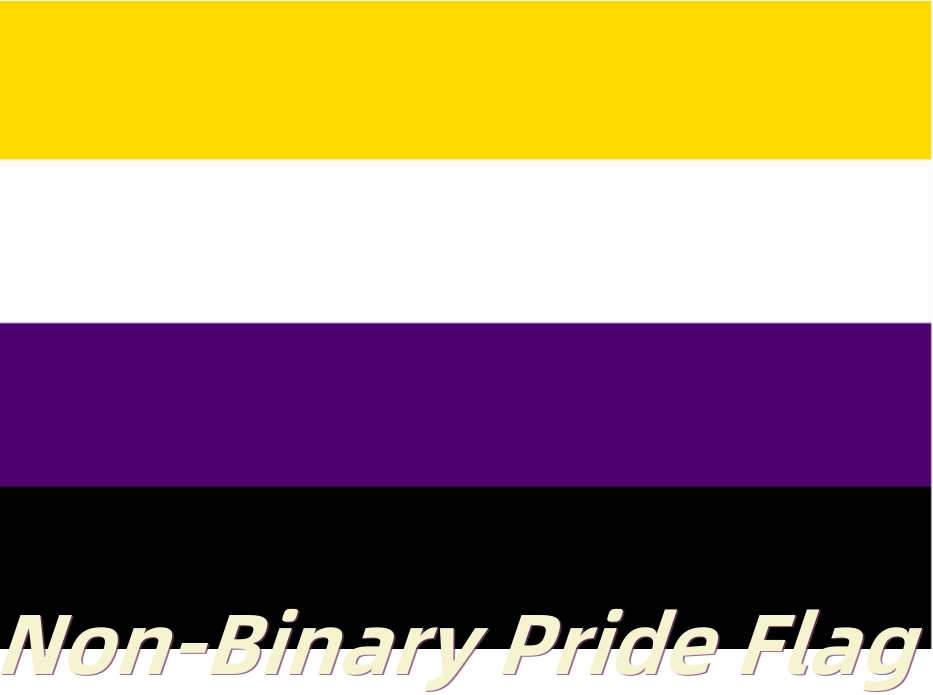
The Flag of Non-Binary Pride is a symbol representing individuals identifying as non-binary, denoting gender identities beyond the traditional binary paradigm of male and female. Devised by Kye Rowan in 2014, the emblem comprises four horizontal bands of equal breadth. From top to bottom, the colors represent:
- Yellow: Denotes individuals whose gender transcends the binary, encompassing those identifying as agender, bigender, genderfluid, or any other non-binary identity.
- White: Symbolizes individuals with numerous or all genders, as well as those with undefined or multiple genders.
- Purple: Represents individuals possessing a blend of both binary and non-binary genders.
- Black: Signifies agender individuals and those identifying with an absence of gender.
This flag aims to offer visibility, acknowledgment, and solidarity for non-binary individuals within the LGBTQ+ community and broader society. It celebrates the diversity and intricacy of gender identities, challenging traditional gender norms and advocating inclusivity and acceptance.
Pansexual Flag
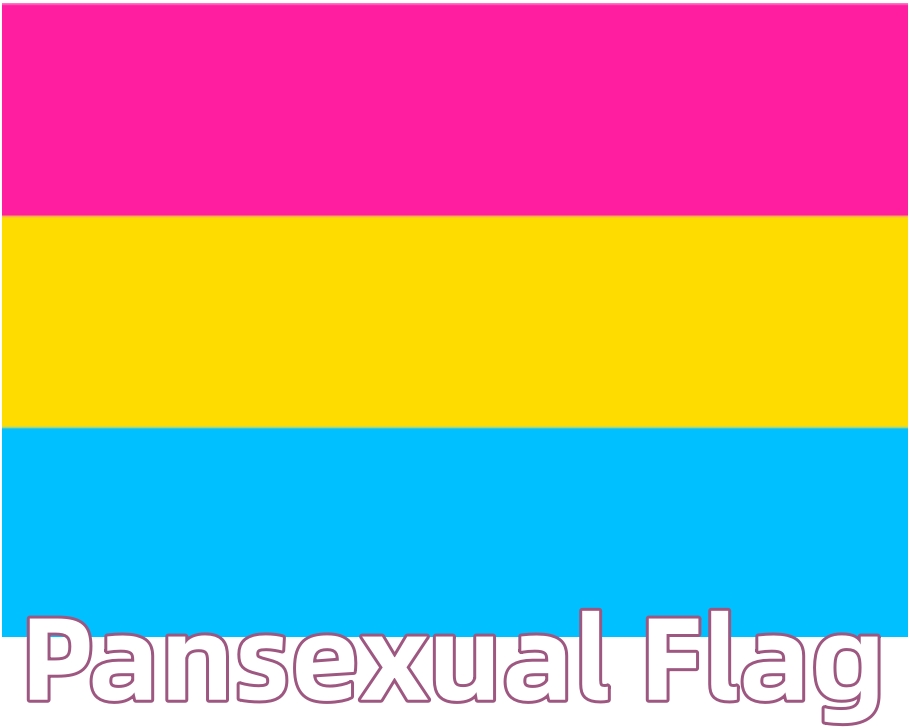
The Pansexual Flag stands as a symbol representing individuals identifying as pansexual, indicating attraction irrespective of gender identity or biological sex. Comprising three horizontal bands—pink, yellow, and cyan—the emblem embodies distinct symbolism.
Pink represents attraction to individuals identifying as female, yellow symbolizes attraction to non-binary individuals, and blue signifies attraction to individuals identifying as male. This emblem was crafted to enhance the visibility and acknowledgment of the pansexual community, offering a symbol of pride and cohesion.
Polysexual Pride Flag
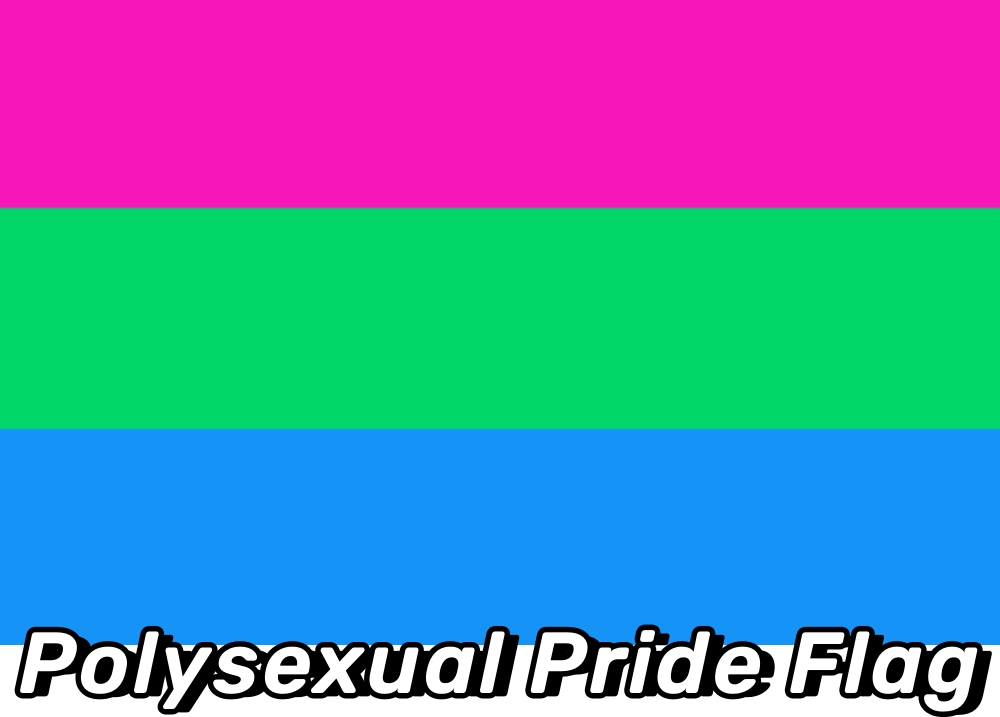
The Polysexual Pride Flag represents those identifying as polysexual, indicating attraction to multiple genders without encompassing all genders. Adorned with three horizontal stripes of pink, green, and blue, each hue conveys specific nuances. Pink symbolizes attraction towards women, green signifies an attraction to non-binary individuals, and blue denotes attraction to men.
By showcasing these colors, the flag strives to elevate visibility and acknowledgment for polysexual individuals within the LGBTQ+ realm, serving as a beacon of pride and unity.
Philadelphia Pride Flag
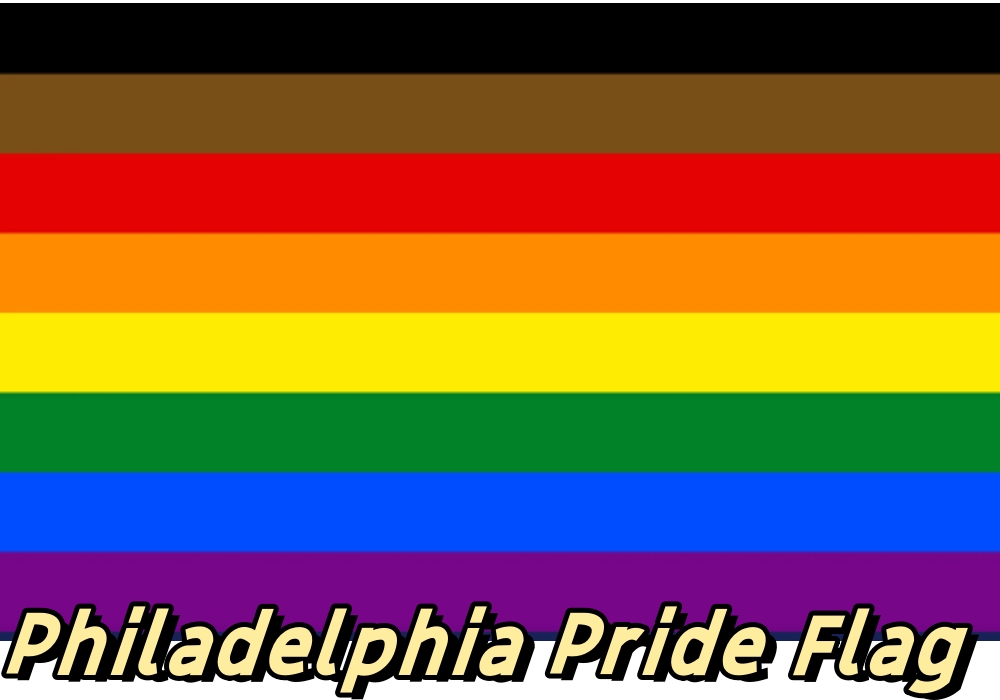
The Philadelphia Pride Flag, also dubbed the "More Color, More Pride" flag, deviates from the conventional rainbow flag. Featuring supplementary black and brown stripes atop the original six-colored rainbow motif, this iteration extends a symbolic hand to Black and Latino LGBTQ+ communities.
This alteration, conceived in 2017 by Philadelphia's Office of LGBT Affairs, seeks to rectify issues of racism and prejudice within the LGBTQ+ collective while fostering greater inclusivity.
Queer Pride Flag

The Queer Pride Flag stands as an emblem of inclusivity and solidarity within the LGBTQ+ sphere. Unlike its counterparts that spotlight specific identities, this flag embraces the broader spectrum of sexual orientations, gender identities, and expressions within the queer community.
Often adorned with a kaleidoscope of colors, it amalgamates elements from various existing pride flags to underscore diversity and harmony. Serving as a poignant reminder of the shared trials and triumphs of LGBTQ+ individuals and allies, it holds sway as a potent symbol.
Transgender Pride Flag

Designed by transgender luminary Monica Helms in 1999, the Transgender Pride Flag comprises five horizontal stripes: two light blue, two pink, and a central white stripe. Symbolically laden, the blue stripes represent traditional male colors, pink denoting female, and white encapsulating intersex, transitioning, or gender-neutral individuals. Serving as a beacon of pride, visibility, and acceptance, this flag stands as a rallying point for the transgender community and its allies.







